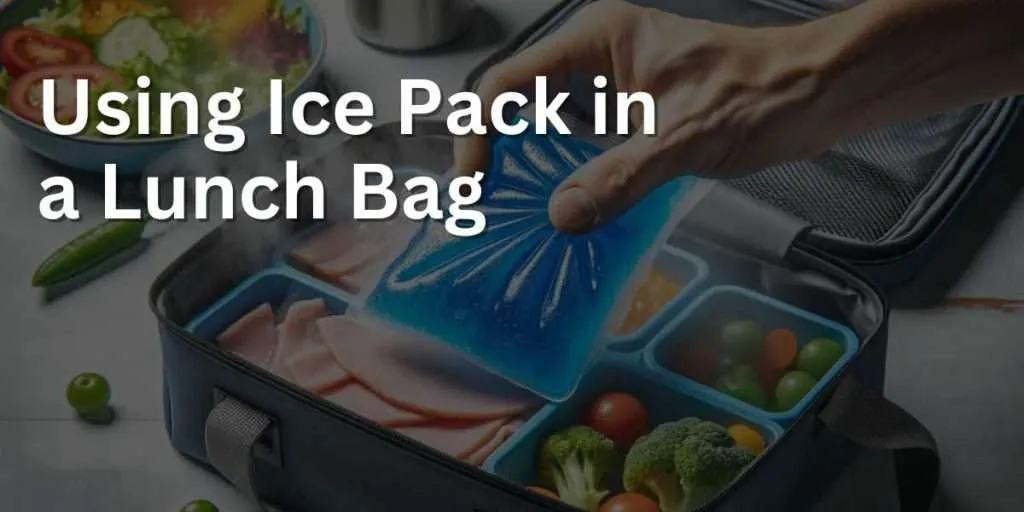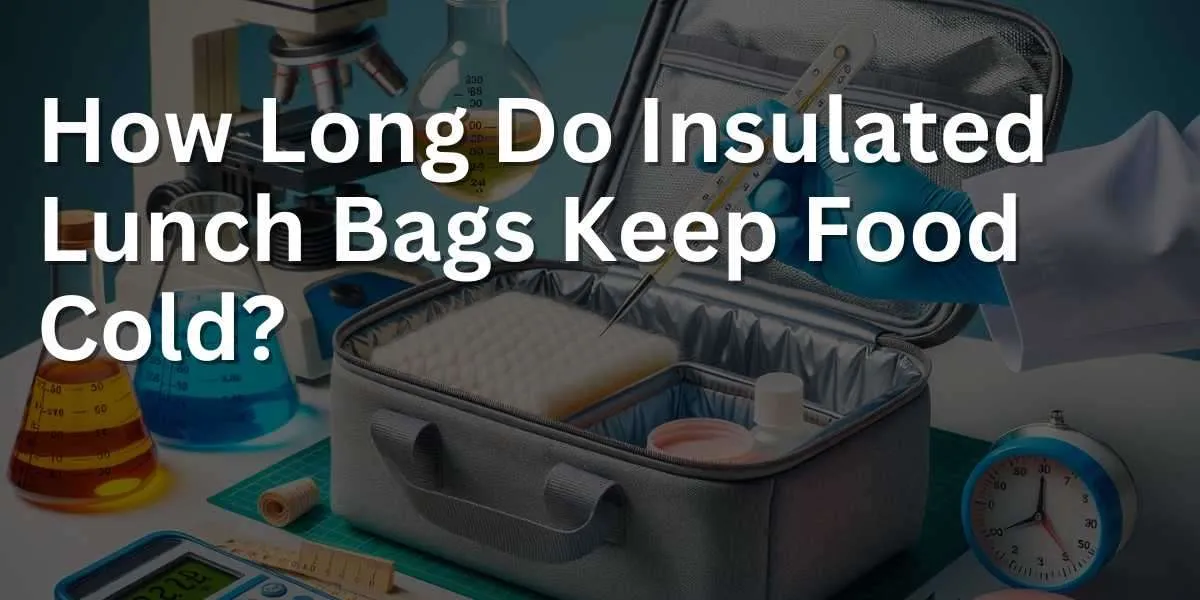If you want to know how long do insulated lunch bags keep food cold then we need to dive into the science of thermal retention in lunchtime carriers.
Insulated lunch bags, celebrated for their promise to keep meals fresh, prompt the question: For how long can they truly maintain that crisp coldness?
If you’ve packed a chilled salad or a cold drink, and are curious about the longevity of its coolness within the confines of the bag, you’re tapping into a universal query.
Join me in this investigation, and let’s unravel the capabilities of insulated lunch bags, ensuring your food remains as refreshing as when first packed.
Insulated lunch bags can keep food cold for about 2 to 6 hours, depending on the quality of the bag and external conditions. Using ice packs or gel packs can extend this duration further. However, for maximum freshness and safety, it’s best to consume the food within 4 hours if not using additional cooling agents.
Key Takeaways on How Long Do Insulated Lunch Bags Keep Food Cold
Insulated lunch bags are designed to maintain the temperature of the food they contain, helping to keep it cold and fresh. The duration for which they can effectively do this depends on several factors:
- Insulation Type: The type of material used for insulation, such as foam, thermal lining, or reflective foil, plays a crucial role. High-quality insulation can enhance cold retention.
- Duration: On average, most insulated lunch bags can keep food cold for about 2 to 8 hours. However, this can vary based on the quality of the bag and other enhancing factors.
- External Factors: The bag’s cooling performance can be influenced by outside conditions. If exposed to direct sunlight or stored in a hot environment like a car, the duration might be reduced.
- Seal/Closure Mechanism: A tight-sealing closure mechanism, whether it’s a zipper, Velcro, or snap, ensures minimal cold air escapes, prolonging the freshness of the food.
- Enhancing Factors: Using ice packs or gel packs can significantly extend the time food remains cold. Some people also pre-freeze their bags to boost their performance.
- Food Type: Foods that are already chilled or frozen (like cold sandwiches or ice packs) can enhance the bag’s ability to stay cold. Conversely, certain perishable foods, like dairy or meats, require consistent and prolonged cooling.
- Usage Pattern: Regularly opening the bag can decrease its efficiency since cold air escapes each time it’s accessed.
- Safety Guidelines: While an insulated bag might feel cold for an extended period, it’s essential to follow safety guidelines for specific foods. For instance, perishable foods shouldn’t be kept out of refrigeration for more than 2 hours (or 1 hour if temperatures are above 90°F).
Insulation Material in Insulated Bag
Insulated lunch bags utilize specialized materials to effectively maintain the cold temperature of the food stored within, ensuring freshness and safety. At the core of these bags is the insulated material, often made from layers of foam or thermal lining, which acts as a barrier, reducing the transfer of heat between the interior and exterior.
Some bags even incorporate a reflective foil lining, which further enhances their ability to retain cold or keep food hot. This lining works by reflecting heat away, thus preserving the internal temperature. The outer layer of the bag, typically crafted from fabrics like nylon or polyester, provides additional insulation to keep food warm while also being durable and water-resistant.
When paired with ice packs or frozen gel packs, the efficiency of these insulated materials is amplified, allowing for extended periods of cold retention. The design, combined with the insulating properties of the materials used, ensures that perishable items remain at a safe temperature, making insulated lunch bags an ideal choice for those looking to keep their meals cold and fresh on the go.
The duration of insulation in a lunch bag to keep lunch cold is determined by several factors that collectively influence its efficiency. Firstly, the type and thickness of the insulated material play a pivotal role; bags with thicker insulation or those using advanced thermal materials tend to retain coldness longer. Generally, a well-insulated lunch bag can maintain a cold temperature for 2 to 8 hours, but this range can vary.
The inclusion of ice packs or frozen gel inserts can substantially extend this duration, providing consistent coldness throughout the day. The frequency of opening the bag can also impact the insulation duration; frequent access allows cold air to escape and warm air to enter, reducing the bag’s overall efficiency.
Seal Quality in Lunch Bag To Keep Lunch Cold
The quality of the seal in a lunch bag is a crucial element in its ability to keep lunch cold. A high-quality seal, often achieved through zippers, Velcro, or snap closures, ensures that the cold air remains trapped inside the bag and that warm external air is kept out.
This airtight environment aids in maintaining a consistent internal temperature, vital for food preservation and freshness. Moreover, a robust seal prevents potential leakages or spills from the inside, especially if the bag contains ice packs that might condense or beverages that could tip over.
Over time, wear and tear can degrade the effectiveness of the seal, so it’s essential to periodically check its integrity. Furthermore, a compromised seal can also allow moisture to enter, which might result in unwanted condensation inside the bag.
For those prioritizing prolonged cold retention, opting for lunch bags with reinforced or double-sealed closures can offer added assurance. In essence, the seal’s quality directly influences the lunch bag’s performance, making it a key feature to consider when aiming for optimal coldness retention.
External Factors Affecting Lunch Bag Ability To Keep Lunch Cold
External factors play a significant role in determining a lunch bag’s ability to keep its contents cold. One of the primary influencers is the ambient temperature; a lunch bag placed in a hot environment, such as a car under the sun, will struggle more to retain its internal coolness compared to one kept in a shaded, cooler area.
Direct sunlight can rapidly increase the bag’s external temperature, diminishing its insulating properties.
Another factor is humidity; in high-humidity conditions, condensation can form on the bag, potentially affecting its thermal performance.
Airflow around the bag can either help disperse heat or introduce warmth, depending on the surrounding temperature.
The surface on which the bag is placed can also influence its efficiency; for instance, placing a lunch bag on a hot metal table might reduce its cooling capability more than if it were on a wooden or cloth surface.
External pressures, such as stacking heavy items on the bag, might compress its insulating layers, reducing their effectiveness. To maximize the cooling ability of a lunch bag, it’s essential to be mindful of these external factors and make adjustments accordingly.

Enhancing Factors: Using Ice Pack or Gel
Ice packs are essential components in enhancing a lunch bag’s ability to keep its contents cold. These packs, filled with gel or liquid that can be frozen, act as portable cold reservoirs that release coldness gradually over time, maintaining a consistently low temperature inside the bag.
The thermal energy transfer between the frozen gel pack and the food ensures that perishable items remain at safe temperatures, especially during prolonged periods away from refrigeration. The size, quantity, and placement of ice packs can be adjusted based on the volume of the lunch and the desired duration of cold retention.
Some lunch bags even come with dedicated compartments or pockets designed specifically for ice packs, ensuring optimal cold distribution. While ice packs are highly effective, it’s crucial to ensure they are fully frozen before use and to periodically check for any signs of wear or leaks.
Using ice packs not only extends the freshness and safety of the food but also offers flexibility in meal choices, allowing for a broader range of items to be included in one’s packed lunch.
Do you need an Insulated Bag?
Some foods are best chilled, others taste better at room temperature, and some foods need to be chilled in order to keep them fresh and safe to eat. Whether you need an insulated lunch bag or insulated lunch boxes really depends on what you are taking with you, or sending your children to school as well as the time of year and whether or not you have access to a fridge.
For most children if they take a packed lunch to school it will be in their bags or collected in a box in the corner of a classroom from the time they leave the house in the morning to the time they get to eat it at lunchtime which can easily be 3-4 hours.
For many foods such as a packet of crisps this is absolutely fine, but yoghurts and other dairy products, meat and eggs and other perishable foods in particular need to be eaten within a few hours of being out of the fridge and will benefit from being kept cool, particularly in hot weather. So to keep cold lunch cold, put it in an insualted layer.
While having an insulated lunch bag is entirely optional, it’s definitely good to have one. They are designed to keep food fresh or cold for longer periods of time. If you are planning to buy one for you or your child, check its size to make sure it fits your needs.
Why keep food cold?
USDA.gov states for food safety:
Foodborne illness can multiply rapidly at temperatures between 40°F and 140°F. This means that if you are tailgating or leaving in the morning for school or work, you’ll need a plan to keep your food cold. You’ll want to use at least two cold sources in an insulated bag to keep perishable foods in your lunch safe; ice or gel packs in your insulated bag or box work best.
Use an Insulated Lunch Bag to Keep Meals Safe
How insulated lunch bags and boxes help keep food fresh
Insulated lunch bags and lunch boxes help keep food cool and fresh by protecting them from the temperature of the air outside. So if you take food directly out of the fridge and put it in an insulated lunch box the temperature inside the lunch box will drop to lower than that of the air outside.
They don’t act as a chiller though so you need to make sure food is cold first and you don’t put just cooked food or perishable food in that hasn’t been chilled.
Other things you can do
Most lunch bags will be big enough to add an ice pack to keep food cool and fresh, and this is an especially good idea in summer when the outside temperature is generally warmer.
Even better than an ice pack you could try freezing their drink which will defrost slowly, keeping their food cold and meaning they have a refreshing ice-cold drink to have at lunchtime.
If you send you child with a carton of juice this freezes really well, as do most plastic drinks bottles. Stainless steel bottles can usually only be frozen if they are not insulated. Also, don’t forget that water expands when it freezes so you need to make sure you don’t overfill bottles or they may break.
Even just a drink with ice in will keep the contents of the whole lunch bag cooler, providing the bottle isn’t insulated.
Another option is to use insulated lunch bags for high-risk foods. You can get small insulated food jars that are perfect for a portion of yoghurt, cheese, meat or hummus, neither of which are great if they’ve been sitting in a warm bag for hours. And these insulated jars are also perfect for sending warm food in winter.





